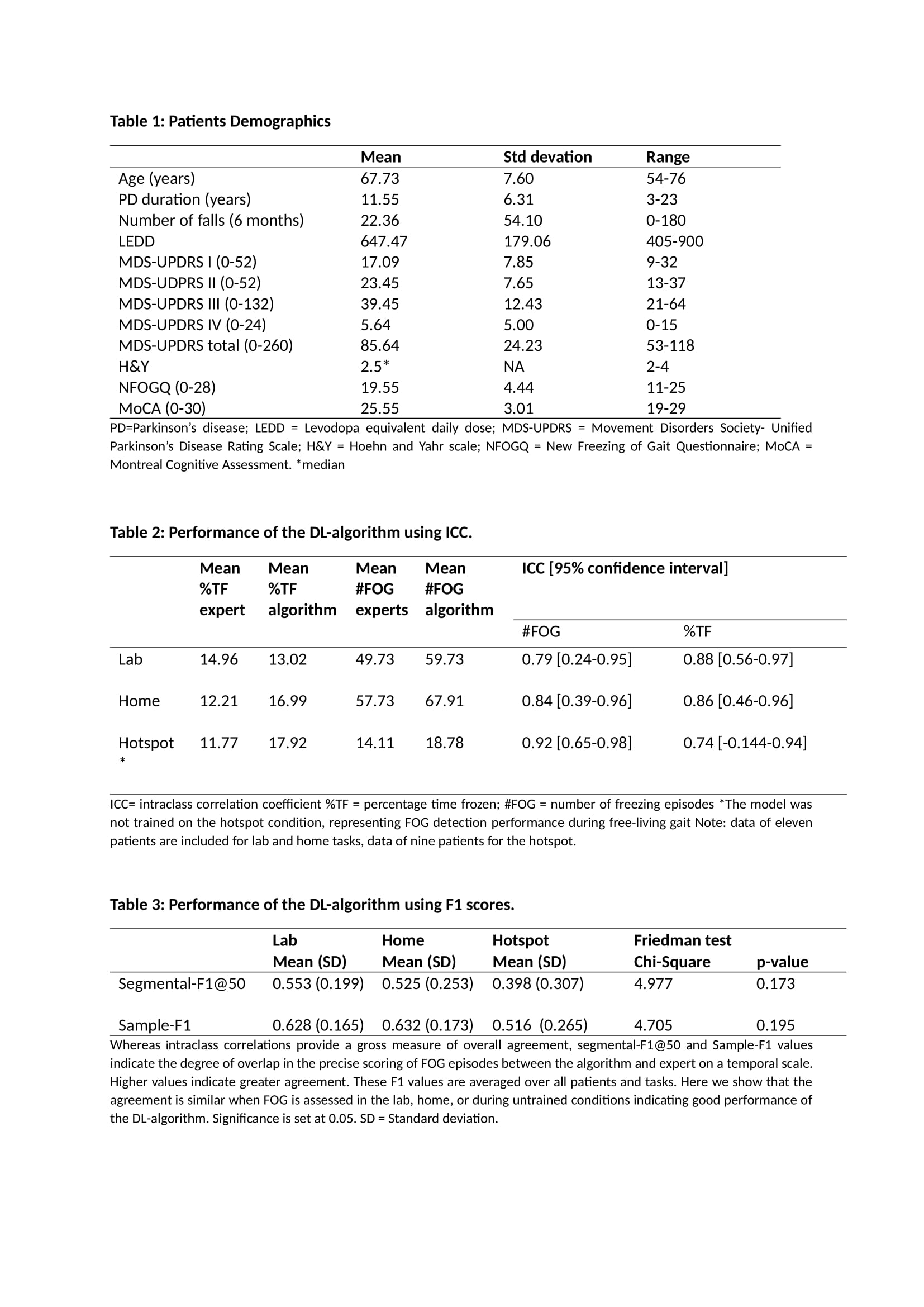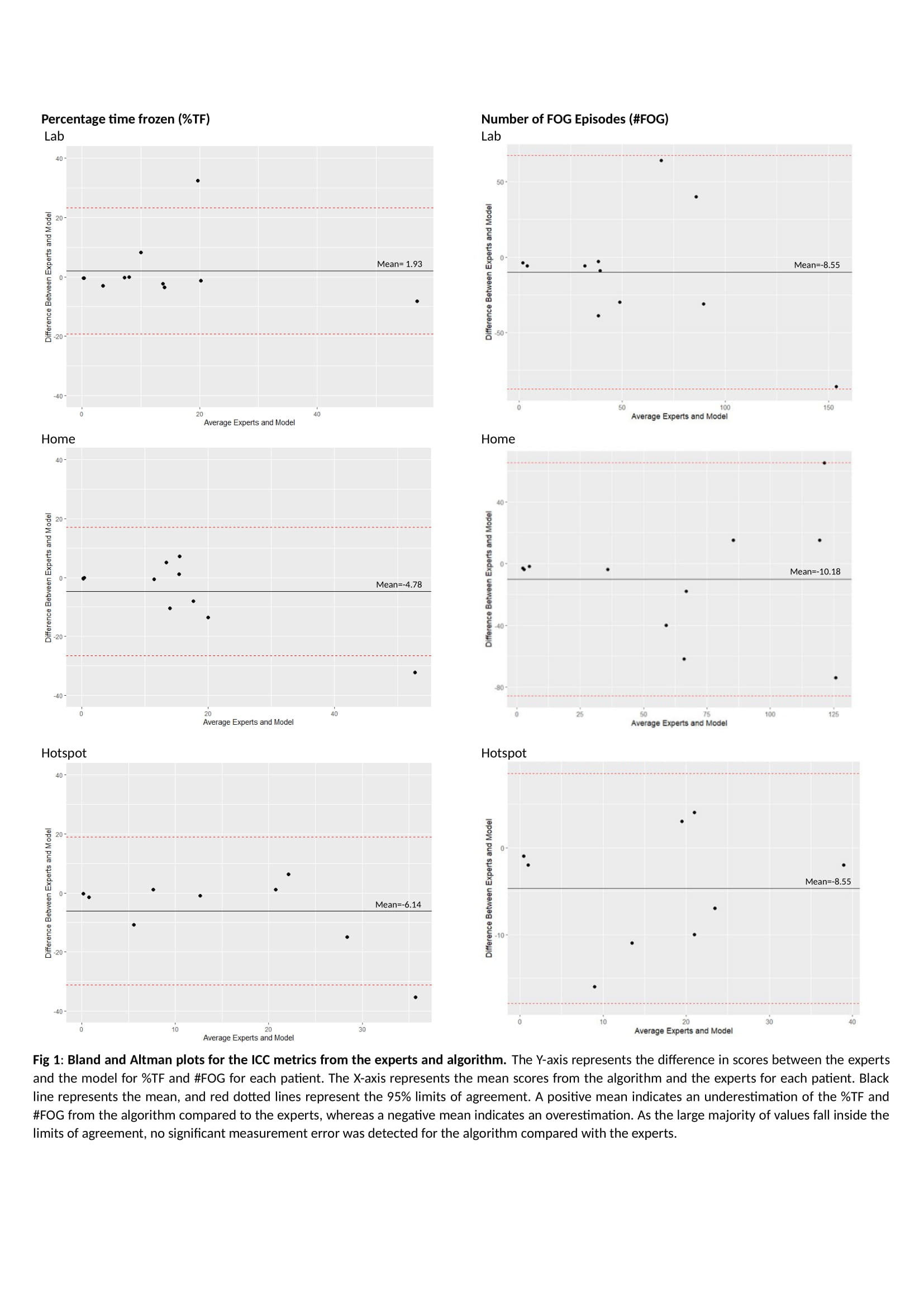Category: Technology
Objective: To validate a deep learning (DL) algorithm to detect Freezing of gait (FOG) at home.
Background: FOG is an episodic gait symptom of Parkinson’s disease (PD) that causes frequent falls(1–3). The current gold standard method to measure FOG is for experts to score episodes from patient videos, which is highly time consuming(4–6). Interestingly, previous lab studies showed strong agreement between an automated DL FOG-detection algorithm and expert ratings, but detection performance in the home is unknown(7,8). Here we evaluated performance of a DL-algorithm to detect FOG in the home during a standardized protocol and a personalized FOG hotspot condition representing free-living gait.
Method: 30 people with PD (PwPD) and self-reported FOG were included. Data has already been scored for eleven patients presented in table 1. A gait protocol was performed in the lab and at home, including Timed-up and go and 360° turning in place tasks with and without stops and dual tasks during both the ON and OFF medication states. Additionally, 9 out of 11 PwPD walked to a self-selected FOG hotspot in the home. Five IMUs were attached at the pelvis, and bilateral tibia and talus. All tasks were video recorded for expert ratings of the number of freezing episodes (#FOG) and percentage time frozen (%TF). A temporal convolution network (TCN) was used for automated FOG detection using a leave-one-out approach. Agreement between algorithm and experts was assessed using Intra Class Coefficients (ICC), as well as sample and segmental F1-scores. Performance of the DL algorithm between lab, home and hotspot FOG detection was compared using a Friedman test.
Results: Agreement between experts and algorithm was good for %TF and #FOG in both the lab and home if the model was trained on all tasks, table 2. When untrained for the hotspot condition representing free-living gait, still an excellent agreement was found for #FOG, but only a moderate agreement for %TF. Table 3 further shows that the F1 scores remained consistent between the three conditions.
Conclusion: Good-to-excellent agreement was found between the algorithm and experts in the lab and home, with the algorithm achieving similar levels of agreement as typically seen between two human raters. The moderate agreement for %TF in the hotspot condition indicates that the algorithm still requires refinement for FOG detection during free living gait.
table 1 until table 3
Figure 1
References: 1. Nutt JG, Bloem BR, Giladi N, Hallett M, Horak FB, Nieuwboer A. Freezing of gait: Moving forward on a mysterious clinical phenomenon. Vol. 10, The Lancet Neurology. 2011. p. 734–44.
2. Fasano A, Canning CG, Hausdorff JM, Lord S, Rochester L. Falls in Parkinson’s disease: A complex and evolving picture. Vol. 32, Movement Disorders. John Wiley and Sons Inc.; 2017. p. 1524–36.
3. Pelicioni PHS, Menant JC, Latt MD, Lord SR. Falls in parkinson’s disease subtypes: Risk factors, locations and circumstances. Int J Environ Res Public Health. 2019 Jun 1;16(12).
4. Gilat M. How to Annotate Freezing of Gait from Video: A Standardized Method Using Open-Source Software. J Parkinsons Dis. 2019;9(4):821–4.
5. Lewis S, Factor S, Giladi N, Nieuwboer A, Nutt J, Hallett M. Stepping up to meet the challenge of freezing of gait in Parkinson’s disease. Vol. 11, Translational Neurodegeneration. BioMed Central Ltd; 2022.
6. Mancini M, Bloem BR, Horak FB, Lewis SJG, Nieuwboer A, Nonnekes J. Clinical and methodological challenges for assessing freezing of gait: Future perspectives. Vol. 34, Movement Disorders. John Wiley and Sons Inc.; 2019. p. 783–90.
7. Filtjens B, Ginis P, Nieuwboer A, Slaets P, Vanrumste B. Automated freezing of gait assessment with marker-based motion capture and multi-stage spatial-temporal graph convolutional neural networks. J Neuroeng Rehabil. 2022 Dec;19(1).
8. Yang PK, Filtjens B, Ginis P, Goris M, Nieuwboer A, Gilat M, et al. Freezing of gait assessment with inertial measurement units and deep learning: effect of tasks, medication states, and stops. J Neuroeng Rehabil. 2024 Dec 1;21(1).
To cite this abstract in AMA style:
M. Goris, P. Yang, P. Ginis, B. Filtjens, B. Vanrumste, A. Nieuwboer, M. Gilat. Automatic detection of Freezing of gait in Parkinson’s disease with IMU: validation of a deep learning algorithm in the home. [abstract]. Mov Disord. 2024; 39 (suppl 1). https://www.mdsabstracts.org/abstract/automatic-detection-of-freezing-of-gait-in-parkinsons-disease-with-imu-validation-of-a-deep-learning-algorithm-in-the-home/. Accessed December 20, 2025.« Back to 2024 International Congress
MDS Abstracts - https://www.mdsabstracts.org/abstract/automatic-detection-of-freezing-of-gait-in-parkinsons-disease-with-imu-validation-of-a-deep-learning-algorithm-in-the-home/


